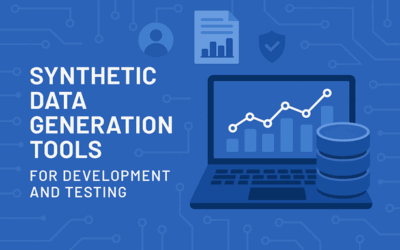Structured Versus Unstructured Data
- Evolution of data
- What is structured data?
- What is unstructured data?
- Working with structured and unstructured data
Evolution of Data
A good starting point to understand the difference between structured and unstructured data is to look at the evolution of data storage and analytic tools over time.
In the past, Excel spreadsheets and simplistic business intelligence tools were the main means to analyze data. However, tools have evolved, and advanced techniques such as natural language processing (NLP), text analytics, and data mining have emerged.
How did we go from simple Excel spreadsheets to massive unstructured databases and complex data mining techniques? This revolution in data analysis resulted from the transition from structured data to the production of massive amounts of unstructured data in the past decade. There are many factors that led to this. One is the advent of IoT (Internet of Things) systems, such as a smart home security system that constantly records and generates unstructured data during all times of the day. Moreover, we live in a digital era where each click, view, like, post, and picture generates data.
Data is the most abundant resource of the 21st century. You might have come across phrases that give you a sense how important data has become, like “data is the future” and “data fuels the 21st century.“
Back in 2018, the world generated around 2.5 quintillion bytes of data each day. This adds up to a whopping 33 zettabytes for the whole year! One zettabyte is equal to 270 bytes. Let that number sink in.
Structured and unstructured data are the two broad classes of data. It is essential to understand the structure of the data you’re dealing with in order to truly extract value from it.
What Is Structured Data?
Structured data, simply put, has a predefined structure and order to it. A computer can easily interpret what the data means because the data inherits a structure.
Data models define the underlying structure of structured data. A data model is a blueprint of a data pipeline that determines how data is labeled, stored, processed, and analyzed. Since structured data adheres to a data model, structured data is easy to access and analyze.
Another property of structured data is its specificity. It gives you precise information that can be studied and queried to easily solve data-driven problems. For instance, consider sales transactions that adhere to a tabular format. Rows represent the respective transactions and columns represent features or properties of the data, such as sale ID, product ID, customer ID, and price. Data of this type is easily searched and can be queried to obtain specific insights, such as how many customers buy each product, which products should be bundled up for a discount offer, and so on.
Additionally, relational databases store structured data and Structured Query Language (SQL) is used to search and query a relational database.
So far, it should be clear that structured data makes data analysis easy. However, structured data accounts for only 20% of the data out there. The rest is unstructured data.
What Is Unstructured Data?
Text messages, Instagram videos, Facebook pictures, emails, YouTube videos, audio files, and other media produce massive amounts of unstructured data. Unstructured data is quite open-ended when compared to the discrete form of structured data. For example, comments on a YouTube video are not binary and do not adhere to a structure. Rather, such data is quite generic, which makes it more difficult for an algorithm to interpret.
Due to the lack of a predefined format, unstructured data cannot be stored in Excel spreadsheets. It does not adhere to a data model and thus has no defined format. The lack of a predefined structure makes it difficult to process and analyze unstructured data.
Despite these pitfalls, unstructured data is of utmost importance. This is because of the type of information that can be retrieved from it. Recent advancements in the field of artificial intelligence, like machine learning, have focused on the analysis of user generated data. Online retailers and social media platforms rely heavily on unstructured data produced by users to study user behavior.
For example, Netflix studies the data patterns of each user to recommends movies, Facebook uses pictures users uploaded to build an image recognition system, and Amazon exploits user-generated data to drive their recommendation engine and boost sales. The applications of unstructured data are endless.
It’s no surprise that unstructured data accounts for around 80% of the data generated today. It takes up a huge amount of storage space and because of its lack of structure, it must be stored in non-relational databases, like NoSQL.
Working With Structured and Unstructured Data-
Structured data and unstructured data
Apart from the obvious difference in the degree of organization, the means of storage for structured and unstructured data differs.
Relational databases utilize a tabular format, like Excel spreadsheets, to organize structured data. On the other hand, unstructured data cannot be stored in tabular formats or relational databases, because the distinction between classes in the data are highly ambiguous.
Another major difference between the two types of data is the ease with which one can analyze and derive useful insights from the them.
While structured data is significantly easier to analyze through the use of business intelligence tools, no fully developed analytical tool yet exists to break down unstructured data. Data-driven methods that rely on artificial intelligence, like NLP, machine learning, and text mining have been helpful in retrieving useful insights.
Furthermore, recent efforts focused on storing unstructured data in simplified formats (such as XML) by building several application frameworks, have contributed to simplifying the process of data analysis.
Another difference is that only structured data provides relevant data descriptions, commonly known as metadata. Metadata is a set of fields that describes the properties and the context of the data in question. Such information is key for search engines to be able to query and extract relevant information.
In the case of unstructured data, data descriptions can be quite ambiguous because the data in question is more generic, making it difficult to categorize.
Future of Big Data –
Most tech giants are chasing after unstructured data. However, there are both challenges and rewards associated with this.
The challenges involve expanding computational load and efficiency, managing massive amounts of storage space, and finding and supporting the right infrastructure and analytical tools to extract applicable data.
However, when a data processing pipeline is well designed, the insights derived from unstructured data can enhance customer acquisition, targeted marketing, market basket analysis, and much more.
Today’s heavy reliance on data creates a huge demand for data-driven skills. This is especially true in the fields of big data analytics, artificial intelligence, statistics, and other related data-oriented domains. To acquire these skills, it’s essential to have a basic understanding of how data really works.
Furthermore, to explore ways of analyzing data, it is necessary to fully understand the organization and preprocessing of data. While there is a lot more to learn, I hope this introduction gave you an intuitive understanding of structured and unstructured data, their differences, and the importance of data analysis in today’s world.
With this, we come to the end of this blog post. Stay tuned for more informative articles!
Learn More or Share Ideas
If you’d like to learn more about Data, Release or Environment Management or perhaps just share your own ideas then feel free to contact the enov8 team. Enov8 provides a complete platform for addressing organisations “DevOps at Scale” requirements. Providing advanced “out of the box” Holistic Test Data Management, IT & Test Environment Management & Release Management capabilities.
Innovate with Enov8, the IT Environment & Data Company.
Specializing in the Governance, Operation & Orchestration of your IT systems and data.
Relevant Articles
7 Synthetic Data Generation Tools for Dev & Testing
In software development and testing, having access to high-quality, realistic data is crucial. But real production data is often sensitive, regulated, or simply unavailable for testing purposes. Synthetic data generation tools provide a powerful alternative, enabling...
The SAFe Hierarchy and Levels, Explained in Depth
The Scaled Agile Framework (SAFe) is a comprehensive set of principles and practices designed to help organizations adopt agile methods on an enterprise level. It provides a set of guidelines and best practices that enable large-scale product development with agility....
DORA Compliance – Why Data Resilience is the New Digital Battlefield
How Enov8 Helps Financial Institutions Align with the EU's Digital Operational Resilience Act Executive Introduction As of January 2025, the EU's Digital Operational Resilience Act (DORA) has become legally binding for financial institutions operating across the...
Data Fabric vs Data Mesh: Understanding the Differences
When evaluating modern data architecture strategies, two terms often come up: data fabric and data mesh. Both promise to help enterprises manage complex data environments more effectively, but they approach the problem in fundamentally different ways. So what’s...
What Is Release Management in ITIL? Guide and Best Practices
Managing enterprise software production at scale is no easy task. This is especially true in today’s complex and distributed environment where teams are spread out across multiple geographical areas. To maintain control over so many moving parts, IT leaders need to...
Test Environment: What It Is and Why You Need It
Software development is a complex process that requires meticulous attention to detail to ensure that the final product is reliable and of high quality. One of the most critical aspects of this process is testing, and having a dedicated test environment is essential...










